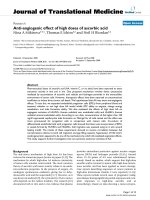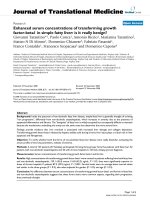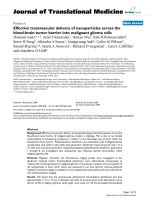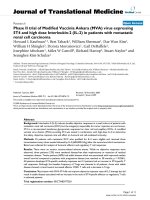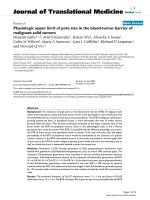Báo cáo hóa học: " Mutation or loss of Wilms’ tumor gene 1 (WT1) are not major reasons for immune escape in patients with AML receiving WT1 peptide vaccination" ppt
Bạn đang xem bản rút gọn của tài liệu. Xem và tải ngay bản đầy đủ của tài liệu tại đây (220.51 KB, 4 trang )
RESEA R C H Open Access
Mutation or loss of Wilms’ tumor gene 1 (WT1)
are not major reasons for immune escape in
patients with AML receiving WT1 peptide
vaccination
Antonia Busse
1*
, Anne Letsch
1
, Carmen Scheibenbogen
2
, Anika Nonnenmacher
1
, Sebastian Ochsenreither
1
,
Eckhard Thiel
1
, Ulrich Keilholz
1
Abstract
Background: Efficacy of cancer vaccines may be limited due to immune escape mechanisms like loss or mutation
of target antigens. Here, we analyzed 10 HLA-A2 positive patients with acute myeloid leukemia (AML) for loss or
mutations of the WT1 epitope or epitope flanking sequences that may abolish proper T cell recognition or epitope
presentation.
Methods: All patients had been enrolled in a WT1 peptide phase II vaccination trial (NCT00153582) and ultimately
progressed despite induction of a WT1 specific T cell response. Blood and bone marrow samples prior to
vaccination and during progression were analyzed for mRNA expression level of WT1. Base exchanges within the
epitope sequence or flanking regions (10 amino acids N- and C-terminal of the epitope) were assessed with
melting point analysis and sequencing. HLA class I expression and WT1 protein expression was analyzed by flow
cytometry.
Results: Only in one patient, downregulation of WT1 mRNA by 1 log and loss of WT1 detection on protein level at
time of disease progression was observed. No mutation leading to a base exchange within the epitope sequence
or epitope flanking sequences could be detected in any patient. Further, no loss of HLA class I expression on
leukemic blasts was observed.
Conclusion: Defects in antigen presentation caused by loss or mutation of WT1 or downregulation of HLA
molecules are not the major basis for escape from the immune response induced by WT1 peptide vaccination.
Background
Over-expression of Wilms’ tumor gene 1 (WT1) is present
in a variety of malignant tumors, including acute leuke-
mias [1-3] and a variety of solid neoplasms [4]. The WT1
protein is a transcription factor critically involved in
tumor cell proliferation, making it a suitable target for
therapeutic strategies including vaccine approaches [5].
Clinical vaccination trials with WT1 peptides and protein
in AML/MDS have been recently initiated leading to the
induction of epitope specific cytotoxic T cells and unpre-
ced ented clinical efficacy [6-8]. However, even in case of
induction of a robust T cell response cancer vac cines in
general have only limited efficacy. Several immune escape
mechanisms have been identified [9-11]. Important escape
mechanisms on tumor cell site are loss or downregulation
of tumor associated antigens (TAA) and mutation of TAA
[12,13]. A mutation within the sequence of an epitope
may abolish proper HLA class I binding, T cell recognition
or proteasomal processing. Another less recognised
mechanism interfering with antigen presentation may be a
mutation of the flanking sequence of an epitope that may
prohibit or decrease processing of the epitope by the pro-
teasome or extraproteasomal proteases [14,15]. In addi-
tion, antigen presentation can be distorted by mechanisms
such as decrease in HLA class I expression [16-18] or
alterations in the antigen processing pathway [19-21].
* Correspondence:
1
Charité - CBF, Department of Medicine III, Berlin, Germany
Busse et al. Journal of Translational Medicine 2010, 8:5
/>© 2010 Busse et al; licensee BioMed Central Ltd. This is an Open Access article distributed u nder the terms of the Creative Comm ons
Attribution License (http: //creativecommons .org/lice nses/by/2.0), which permits unrestricted use, distribution, and reproduction in
any medium, provided the original work is properly cited.
Here we address loss or mutation of WT1 as a poten-
tial immune evasion mechanism in patients from a clini-
cal phase II trial of WT1 peptide vaccination in acute
myeloid leukaemia (AML).
Methods
Patients
Patients were treated within a phase II vaccination trial
(NCT00153582) [8] and received sequential vaccinations
with the HLA-A2-restricted WT1 126-134 peptide +
KLH and GM-CSF as adjuvants. Detailed patient charac-
teristics are previously published in Keilholz et al 2009:
patientno1;no4;no5;no8;no9;no11;no12;no
13; no 15; one patient is not published yet) [8]. All
patients gave written informed consent to participate in
the study according to the Declaration of Helsinki. The
study was approved by the local ethics board.
Blood and bone marrow samples
Bone marrow and peripheral blood samples have been
collected before va ccination and during progression in
heparinized tubes and mononuclear cells (MNCs) were
isolated by Ficoll Isopaque density gradient centrifuga-
tion (Pharmacia, Germany).
mRNA extraction and reverse transcription
Samples were resuspended in guanidium thiocyanate
(GTC) buffer and stored at - 80°C. Further processing of
samples was performed as previously described [22]. In
brief, total RNA was isolat ed by RNeasy Mini Kit
including RNase-Free DNase Set (Qiagen, Germany)
according to the manufactures recommendations. For
reverse transcription, Omniscript Reverese Transcript ase
kit (Qiagen, Germany) was used.
Quantification of WT1 expression levels
Quantitative Real Time RT-PCR assays were performed
using a LightCycler (Roche Diagnostics) with specific
primers for W T1 and the housekeeping gene porpho-
bilinogen deaminase (PBGD) as described elsewhere
[22]. For quantification, PCR products generated from
WT1 cDNAs and from porphobilinogen deaminase
(PBGD) cDNAs were cloned into the vector pCR2.1-
TOPO (Invitrogen, The Netherlands). A standard
curve with 3 dilutions of the appropriate plasmid in
duplicates was included in each PCR run. Analysis of
RT-PCR expression data was performed with the
LightCycler software (version 3). Crossing points were
assessed by the second derivate maximum algorithm
and plotted against the concentrations of the stan-
dards. Sample concentrations were calculated using the
plasmid standard curve resulting in marker concentra-
tions. All samples were analysed in duplicate. The
average value of both duplicates was used as a quanti-
tative value. To correct for differences of cDNA
amount on a per-sample basis, results were provided
asratiotoPBGDexpression.
Mutation analysis
Base exchanges within the epitope sequence or epitope
flanking sequences (10 amino acids N- and C-terminal
of the epitope) were analyzed with melting point analy-
sis after amplification wi th the specific primers WT1
Mut fw 5’ -TGTCCACTTTTCCGGC-3’ and WT1 Mut
rev 5’ -GTCCCGTCGAAGGTGA-3 on a LightCycler
instrument. To cover the whole sequence 2 wild-type
complementary detection probe pairs were used (P,
dephosphorylated; X, Fluorescein; Y, LC Red 640): probe
pair 1: 5’-Y GCGCGTTAGGAAACATCCTGG P, 5’-
TGGCCGGATGACGCCTGG X, probe pair 2: 5’ -Y
CTGGGCAGGTAGGGC P, 5’-TTAGGAAACATCCTG
GCCTGGCCG X. To confirm the results obtained by
melting curve analysis sequencing was performed in 4
patients.
Flow cytometry
For determination of HLA Class I expression and HLA-
A2 expr ession, leukemic blasts were stained with FITC
conjugated anti-HLA class I monoclonal antibody
(mAb) B9.12.1 (Beckmann Coulter) and with Alexa 647
conjugated mAb anti-HLA-A2 BB7.2 (AbSerotec)
respectively. For exclusion of monocytes and lympho-
cytes samples were additionally stained with PerCP con-
jugated anti CD3 mAb and anti CD14 mAb (both BD
Bioscience) and for exclusion of dead cells the LIVE/
DEAD Fixable Violet Dead Cell Stain Kit (Molecular
Probes) was used. For detection of WT1 expression in
leukemic blasts extracellular staining was done with PE-
conjugated mAb against CD34 (Becton Dickinson) and
intracellular staining with mAbs against WT1 (clon e 6F-
H2, Dako) as primary antibody and goat anti mouse
(GAM)-FITC (JacksonImmunoResearch) as secondary
antibody. T cell response assessment was carried out as
described in detail in Keilholz et al 2009 [8]. A cytokine
response was considered positive if the percentage of
WT1-peptide-specific cytokine producing CD3+CD8+T
cells was at least 2-fold the percentage of cytokine pro-
ducing CD3+CD8+T cells in response to an HIV control
peptide; a tetramer response was considered positive if
the frequency of tetramer positive CD3+CD8+ T cells
exceeded 0.3%, which was the mean + 2 standard devia-
tions (0.16% + 0.14%) observed in 12 healthy control
subjects.
Data acquisition was performed on a FACSCalibur
(Becton Dickinson) and data were analyzed using Cell-
Quest software.
Results and Discussion
Ten HLA-A2 positive patients with AML were analysed
for mRNA expression levels of WT1 and for mutations
of the WT1 epitope or epitope flanking sequences. All
patients had received sequential vaccinations with the
HLA-A2-restricted WT1 126-134 peptide with adjuvants
Busse et al. Journal of Translational Medicine 2010, 8:5
/>Page 2 of 4
within a phase II vaccination trial and progressed after
an initial interval of vaccine efficacy [8]. T cell response
to vaccination was analyzed as previously published in
Keilholz et al 2009 (patient no 1; no 4; no 5; no 8; no 9;
no 11; no 12; no 13; no 15; one patient is not published
yet) [8]: In 8 of these 10 patients WT1 126-134 tetramer
+ T cells during the course of vaccination were found in
peripheral blood (mean percentage of WT1 126-134 tet-
ramer + cells in t he CD3+ CD8+ T cell po pulation
0.76% [0.3%-1.09%]). Moreover, to analyze the functional
activity o f WT1 126-134 specific T cells raised by vacci-
nation, the reactivity of CD3+CD8+ T cells against
WT1 126-134 peptide loaded cells was measure d by
intracellular IFN-g and/or TNF-a cytokine staining. In 8
of 10 patients the presence of TNF-a and/or IFN-g pro-
ducing WT1 126-134 specific CD3+CD8+ T cells could
be induced by vaccination. 7 patients showed a TNF-a
response with a mean percentage of TNF-a+ cells in
the CD3+CD8+ T cell population of 0.26% (0.1% - 0.6%)
and 7 patients showed a IF N-g response with a mean
percentage of IFN-g+ cells in the CD3+CD8+ T cell
population of 0.23% (0.09-0.6%). However, one patient
showed no WT1 126-134 tetramer + T cells or cytokine
response in peripheral blood.
As loss or downregulation of tumor antigens are poten-
tial immune escape mechanisms [12,13], first bone mar-
row samples obtained before vaccination and during
progression were analyzed for expression levels of WT1
by real-time RT-PCR. In 9 out of 10 patients bone mar-
row WT1 levels were constant or increased at the time
point of progression mirroring the kinetics of bone mar-
row blasts during treatment (figure 1). In one patient,
however, down-regulation of WT1 by 1 log was observed
although bone marrow blasts reached the same level at
time of disease progression as before vaccination. In this
latter patient WT1 protei n was undetectable by intracel-
lular flow cytometry at time of disease progression, con-
sistent with downregulation of WT1 mRNA and protein
as escape mechanism in this single patient.
WT1 mutations have been reported in about 10% o f
patients with AML [23]. They were frequently observed
in DNA binding portions of the WT1 protein and may
therefore contribute to leukemogenesis [24]. However,
mutations have also been observed in exon 1, affecting
the epitope fla nking regions of the WT1 126 -134 epi-
tope [23]. Mutations of the epitope sequence or its
flanking sequences could represent a possible immune
escape mechanism as they may abolish proper HLA
class I binding, T cell recognition or proteasomal pro-
cessing. Therefore, mutation analysis was performed in
both samples obtained before vaccination and during
progression. However, no mutation leading to a base
exchange within the epitope sequence or epitope flank-
ing sequences could be detected in any patient. As
expected, the known single nucleotide polymorphism C/
T (NM_000378, mRNA position 790, coding positi on 3,
protein residue Asn) at am ino acid position 130 was
observed in 6 patients.
To exclude failure of vaccine efficacy due to HLA
class I downregulation [16-18,25], cell surface HLA class
I expression on leukemic blasts was analyzed in 9
patients by flow cytometry during progression. The
median percentage of HLA class I expres sing blasts was
96% (84%-99%). Compared to HLA class I expression
on blasts before therapy (5 patients analyzed) there was
no significant downregulation. To exclude selective loss
of the HLA-A2 allele, we analyzed HLA-A2 expression
on leukemic blasts of 5 patients. In all 5 patients more
than 90% of blasts stained positive for HLA-A2. In none
of the patients a difference of HLA-A2 expression before
therapy and at the time point of progression was
observed.
Conclusions
We have no evidence for an immune escape due to loss
or mutation of WT1 or HLA class I downregulation as
has been reported for immunotherapy targeting differen-
tiation antigens in melanoma [12]. This finding supports
the use of tumor target antigens like WT1 which a re
crucial for tumor cell proliferation. However, further
studies, especially on mechanisms of immune evasion at
the effector phase of the anti-tumor immune response,
are indicated to determine potential inhibitory immune
mechanisms during WT1 peptide vaccination.
Acknowledgements
We thank David Stather for technical help.
Author details
1
Charité - CBF, Department of Medicine III, Berlin, Germany.
2
Institute of
Medical Immunology, Charité - CCM, Berlin, Germany.
Figure 1 WT1 expression levels before vaccination and during
progression. The relative amount was expressed as ratio WT1 [pg/
μl]/PBGD [pg/μl]). Dotted line: normal bone marrow cut-off level.
Busse et al. Journal of Translational Medicine 2010, 8:5
/>Page 3 of 4
Authors’ contributions
AB has made substantial contributions to conception and design, acquisition
of data, analysis and interpretation of data and wrote the manuscript; AL,
AN and OS have made substantial contributions to acquisition of data,
analysis and interpretation of data. CS have been involved in conception
and design, interpretation of data and revising the manuscript critically for
important intellectual content, ET has made substantial contributions to
conception and design and was involved in revising the manuscript critically
for important intellectual content, UK: has made substantial contributions to
conception and design, as well as analysis and interpretation of data and
wrote the manuscript.
All authors have read and approved the final manuscript.
Competing interests
Supported by a grant from the from the José-Carreras Leukemia Foundation
and from the “Stiftung zur Bekaempfung der Leukaemie”
Received: 1 September 2009
Accepted: 21 January 2010 Published: 21 January 2010
References
1. Inoue K, Ogawa H, Sonoda Y, Kimura T, Sakabe H, Oka Y, Miyake S,
Tamaki H, Oji Y, Yamagami T, et al: Aberrant overexpression of the Wilms
tumor gene (WT1) in human leukemia. Blood 1997, 89:1405-1412.
2. Menssen HD, Renkl HJ, Rodeck U, Maurer J, Notter M, Schwartz S,
Reinhardt R, Thiel E: Presence of Wilms’ tumor gene (wt1) transcripts and
the WT1 nuclear protein in the majority of human acute leukemias.
Leukemia 1995, 9:1060-1067.
3. Miwa H, Beran M, Saunders GF: Expression of the Wilms’ tumor gene
(WT1) in human leukemias. Leukemia 1992, 6:405-409.
4. Nakatsuka S, Oji Y, Horiuchi T, Kanda T, Kitagawa M, Takeuchi T, Kawano K,
Kuwae Y, Yamauchi A, Okumura M, et al: Immunohistochemical detection
of WT1 protein in a variety of cancer cells. Mod Pathol 2006, 19:804-814.
5. Sugiyama H: Cancer immunotherapy targeting WT1 protein. Int J Hematol
2002, 76:127-132.
6. Oka Y, Tsuboi A, Oji Y, Kawase I, Sugiyama H: WT1 peptide vaccine for the
treatment of cancer. Curr Opin Immunol 2008, 20:211-220.
7. Rezvani K, Yong AS, Mielke S, Savani BN, Musse L, SUperata J, Jafapour B,
Boss C, Barrett AJ: Leukemia-associated antigen-specific T-cell responses
following combined PR1 and WT1 peptide vaccination in patients with
myeloid malignancies. Blood 2008, 111:236-242.
8. Keilholz U, Letsch A, Busse A, Asemissen AM, Bauer S, Blau IW,
Hofmann WK, Uharek L, Thiel E, Scheibenbogen C: A clinical and
immunologic phase 2 trial of Wilms tumor gene product 1 (WT1)
peptide vaccination in patients with AML and MDS. Blood 2009,
113:6541-6548.
9. Gajewski TF, Meng Y, Harlin H: Immune suppression in the tumor
microenvironment. J Immunother 2006, 29:233-240.
10. Seliger B: Strategies of tumor immune evasion. BioDrugs 2005, 19:347-354.
11. Kim R, Emi M, Tanabe K: Cancer immunoediting from immune
surveillance to immune escape. Immunology 2007, 121:1-14.
12. Slingluff CL Jr, Colella TA, Thompson L, Graham DD, Skipper JC, Caldwell J,
Brinckerhoff L, Kittlesen DJ, Deacon DH, Oei C, et al: Melanomas with
concordant loss of multiple melanocytic differentiation proteins:
immune escape that may be overcome by targeting unique or
undefined antigens. Cancer Immunol Immunother 2000, 48:661-672.
13. Singh R, Paterson Y: Immunoediting sculpts tumor epitopes during
immunotherapy. Cancer Res 2007, 67:1887-1892.
14. Seifert U, Liermann H, Racanelli V, Halenius A, Wiese M, Wedemeyer H,
Ruppert T, Rispeter K, Henklein P, Sijts A, et al: Hepatitis C virus mutation
affects proteasomal epitope processing. J Clin Invest 2004, 114:250-259.
15. Theobald M, Ruppert T, Kuckelkorn U, Hernandez J, Haussler A, Ferreira EA,
Liewer U, Biggs J, Levine AJ, Huber C, et al: The sequence alteration
associated with a mutational hotspot in p53 protects cells from lysis by
cytotoxic T lymphocytes specific for a flanking peptide epitope. J Exp
Med 1998, 188:1017-1028.
16. Marincola FM, Jaffee EM, Hicklin DJ, Ferrone S: Escape of human solid
tumors from T-cell recognition: molecular mechanisms and functional
significance. Adv Immunol 2000, 74:181-273.
17. Algarra I, Cabrera T, Garrido F: The HLA crossroad in tumor immunology.
Hum Immunol 2000, 61:65-73.
18. Watson NF, Ramage JM, Madjd Z, Spendlove I, Ellis IO, Scholefield JH,
Durrant LG: Immunosurveillance is active in colorectal cancer as
downregulation but not complete loss of MHC class I expression
correlates with a poor prognosis. Int J Cancer 2006, 118:6-10.
19. Seliger B, Atkins D, Bock M, Ritz U, Ferrone S, Huber C, Storkel S:
Characterization of human lymphocyte antigen class I antigen-
processing machinery defects in renal cell carcinoma lesions with
special emphasis on transporter-associated with antigen-processing
down-regulation. Clin Cancer Res 2003, 9:1721-1727.
20. Seliger B, Maeurer MJ, Ferrone S: Antigen-processing machinery
breakdown and tumor growth. Immunol Today 2000, 21:455-464.
21. Garcia-Lora A, Martinez M, Algarra I, Gaforio JJ, Garrido F: MHC class I-
deficient metastatic tumor variants immunoselected by T lymphocytes
originate from the coordinated downregulation of APM components. Int
J Cancer 2003, 106:521-527.
22. Siehl JM, Thiel E, Heufelder K, Snarski E, Schwartz S, Mailander V, Keilholz U:
Possible regulation of Wilms’ tumour gene 1 (WT1) expression by the
paired box genes PAX2 and PAX8 and by the haematopoietic
transcription factor GATA-1 in human acute myeloid leukaemias. Br J
Haematol 2003, 123:235-242.
23. King-Underwood L, Pritchard-Jones K: Wilms’ tumor (WT1) gene mutations
occur mainly in acute myeloid leukemia and may confer drug
resistance. Blood 1998, 91:2961-2968.
24. Summers K, Stevens J, Kakkas I, Smith M, Smith LL, Macdougall F,
Cavenagh J, Bonnet D, Young BD, Lister TA, Fitzgibbon J: Wilms’ tumour 1
mutations are associated with FLT3-ITD and failure of standard
induction chemotherapy in patients with normal karyotype AML.
Leukemia 2007, 21:550-551, author reply 552.
25. Chang CC, Ferrone S: Immune selective pressure and HLA class I antigen
defects in malignant lesions. Cancer Immunol Immunother 2007, 56:227-
236.
doi:10.1186/1479-5876-8-5
Cite this article as: Busse et al.: Mutation or loss of Wilms’ tumor gene 1
(WT1) are not major reasons for immune escape in patients with AML
receiving WT1 peptide vaccination. Journal of Translational Medicine 2010
8:5.
Submit your next manuscript to BioMed Central
and take full advantage of:
• Convenient online submission
• Thorough peer review
• No space constraints or color figure charges
• Immediate publication on acceptance
• Inclusion in PubMed, CAS, Scopus and Google Scholar
• Research which is freely available for redistribution
Submit your manuscript at
www.biomedcentral.com/submit
Busse et al. Journal of Translational Medicine 2010, 8:5
/>Page 4 of 4
